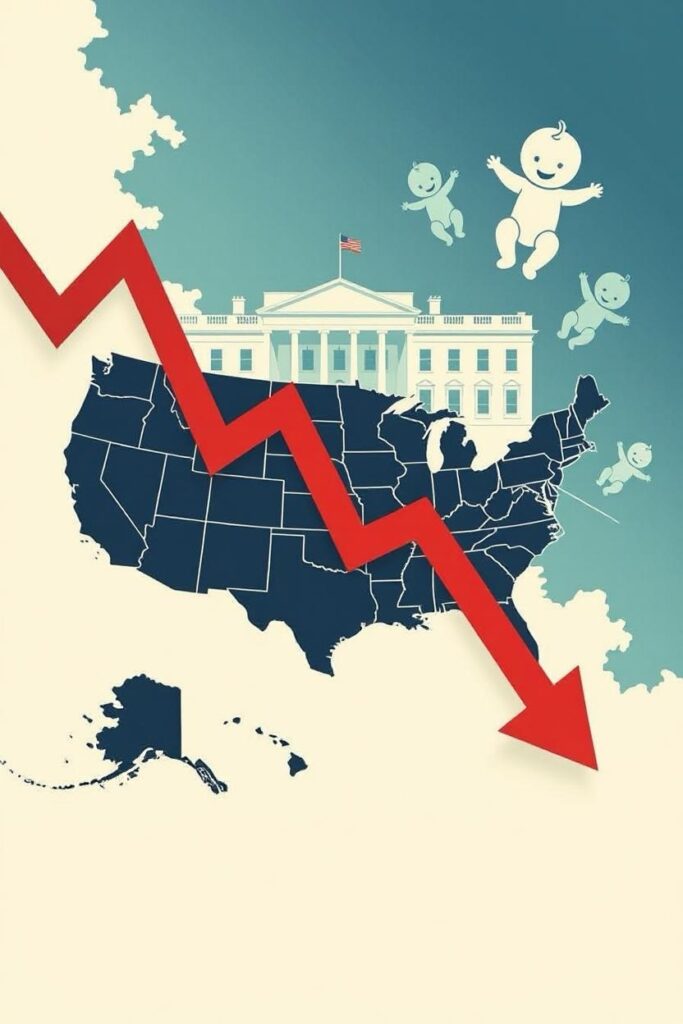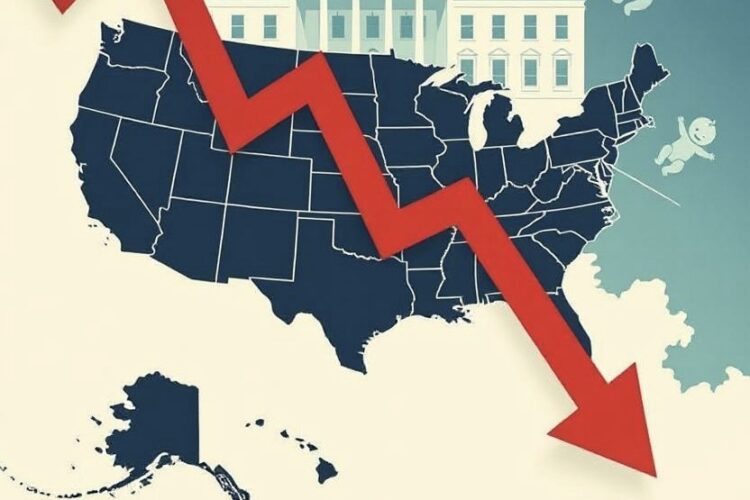The White House has flagged the US fertility rate’s drop to 1.6—below the 2.1 needed to sustain the population—as a national security threat. Historically high during the baby boom, birth rates have fallen since the 1970s due to delayed marriages, fewer teen births, and economic pressures like high housing and childcare costs. Health challenges, including rising maternal mortality and declining sperm counts, worsen the issue, while costly IVF pushes some toward medical tourism. A shrinking workforce threatens economic growth and social programs, raising concerns about national security and inequality. Proposed solutions include child tax credits, baby bonuses, and affordable fertility treatments to boost natural fertility. Policies promoting childcare and parental leave aim to reverse the trend, with optimism that the rate could near replacement levels by 2040 if cultural and economic support aligns.
Long Version
White House Sounds Alarm on Plummeting US Fertility Rate: A National Imperative
In a stark address from the White House press briefing room, officials declared the declining US fertility rate a national security threat, highlighting how the total fertility rate has plummeted from higher levels in past decades to a mere 1.6 today—well below the replacement rate of 2.1 needed to sustain the population without immigration. This warning underscores a broader demographics crisis, where birth rates have hit historic lows, fueling concerns over population decline and its ripple effects on the economy, society, and global standing.
Historical Shifts in US Birth Rates
The story begins with the post-World War II baby boom, when high natural fertility and optimistic economic conditions drove birth rates to peaks of over 3.5 children per woman. Marriage rates were robust, teen births more common, and family planning was less formalized. However, since the 1970s, fertility rates have trended downward, accelerating after 2007 to the current low of about 1.62. This decline mirrors global patterns but poses unique challenges for the US, where immigration has historically offset low birth rates. Without intervention, projections suggest population growth could stall entirely by the early 2030s, relying solely on newcomers.
Unpacking the Causes of Declining Fertility
The roots of this fertility downturn are multifaceted, blending social, economic, and health factors. Socially, delayed marriage rates and fewer teen births—down significantly since 1991—reflect shifting priorities toward education and careers. Tools like menstrual cycle tracking apps have empowered reproductive health decisions, enabling precise family planning and reducing unintended pregnancies. Yet, this has contributed to lower overall birth rates.
Economically, high housing costs, stagnant wages, and inadequate childcare access deter family expansion. Many couples cite these barriers as reasons for smaller families or none at all. Health policy experts point to rising maternal mortality rates, which erode confidence in childbearing, alongside emerging issues like male infertility. Studies show declining sperm counts, potentially linked to environmental toxins, further complicating natural fertility. In vitro fertilization has become a lifeline for many, but its high costs—often exceeding $20,000 per cycle—drive some to medical tourism in countries like Mexico or India for affordable treatments.
Far-Reaching Implications for Economy and Society
The economic implications are profound. A shrinking workforce could slash GDP growth by 1-2 percentage points annually, straining social support systems as fewer workers support an aging population. Budget forecasts already warn of fiscal pressures from reduced fertility, with states facing lower education expenditures but higher eldercare costs. On the national security front, a dwindling native population raises alarms about military recruitment and innovation capacity, framing the issue as a civilization crisis that could undermine global influence.
Demographics experts argue this isn’t just about numbers; it’s a societal shift. Lower birth rates could exacerbate inequality, as wealthier families access advanced reproductive health options while others lag. Pronatalism advocates warn of a birth dearth leading to cultural stagnation. Ironically, while fertility declines boost short-term economic growth through higher female labor participation and savings, long-term population decline threatens sustainability.
Government Intervention and Policy Responses
The White House’s warning signals a pivot toward aggressive government intervention. Recent deals with pharmaceutical companies aim to slash drug prices for fertility treatments, expanding access to high-quality care. This builds on executive orders to reduce costs and barriers for assisted reproductive technologies.
Pronatalist policies are gaining traction, drawing from global models. Proposals include enhanced child tax credits—currently up to $2,000 per child—to ease financial burdens, alongside baby bonuses like one-time payments of $5,000 or more for new births, as seen in some countries. The administration is exploring symbolic awards for large families to culturally promote childbearing.
Think tanks advocate for comprehensive health policy reforms. These include subsidies for menstrual cycle tracking education in schools and incentives for natural fertility enhancement, alongside addressing male infertility via environmental regulations. Even unconventional ideas, like tying scholarships to family-oriented research or international exchanges on demographics, are floated to foster global insights into reversing trends.
Broader family planning support—affordable childcare, paid parental leave, and housing vouchers—could stem the decline, experts say. Reducing maternal mortality through better healthcare access is critical, as is combating medical tourism by making domestic treatments more affordable.
Looking Ahead: Pathways to Recovery
Reversing the US fertility rate requires a holistic approach, blending incentives with cultural shifts. While some predict continued decline, optimistic scenarios suggest policies could nudge the total fertility rate back toward replacement levels by 2040. Success hinges on viewing childbearing not as a burden but a valued choice, supported by robust reproductive health infrastructure.
This White House warning marks a call to action, urging Americans to confront the fertility crisis head-on. By integrating economic relief, health innovations, and pronatalist strategies, the nation can avert deeper population decline and secure its future prosperity.

Hashtags For Social Media
#USFertilityCrisis #WhiteHouseAlert #BirthRateDecline #PopulationDrop #FertilityWarning #DemographicShift #BabyShortage #Pronatalism #FamilyPlanning #ReproductiveHealth #IVFTreatments #MaleInfertility #MaternalHealth #ChildTaxCredit #BabyBonus #NationalSecurityThreat #EconomicImpact #AgingPopulation #MarriageTrends #TeenBirths #NaturalFertility #MenstrualTracking #MedicalTourism #FertilityPolicies #GovernmentIntervention #BirthDearth #CulturalShift #FutureOfAmerica #BoostBirthRates #DemographicsCrisis
Related Questions, Words, Phrases
white house fertility rate warning | us birth rate decline alert from white house | what is the white house saying about us fertility drop | reasons behind us fertility rate falling as per white house | white house issues alert on low us birth rates | impact of declining us fertility according to white house | white house warns about population decline in america | details on white house’s us fertility crisis statement | why is white house concerned about us birth rates | white house report on dropping fertility in the us | us fertility rate drops white house response | white house advisory on american birth rate trends | exploring white house warning over us demographic shift | white house highlights risks of low fertility rates in usa | what does white house mean by fertility rate warning | white house statement on us population growth slowdown | causes of us fertility decline warned by white house | white house urges action on falling birth rates | latest white house update on us fertility statistics | white house declares fertility drop a national issue | implications of white house’s us birth rate alert | white house analysis of declining american fertility | how white house is addressing low us birth rates | white house warning: us fertility below replacement level | full text of white house fertility rate advisory | white house’s take on economic effects of low birth rates | white house calls for policies to boost us fertility | understanding white house’s concern over birth dearth | white house issues stark warning on us demographic crisis | what triggered white house’s fertility rate alert | white house perspectives on reversing us birth decline | expert reactions to white house fertility warning | white house data on historical us birth rate changes | white house proposes solutions for low american fertility | white house warns of security threats from fertility drop






